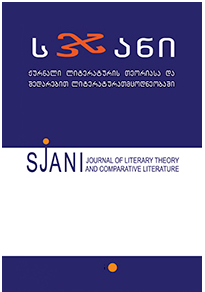ჯოისი და გოეთე: “Un noioso funzionario”?
Main Article Content
ანოტაცია
James Joyce regarded Goethe as being in the great writers’ “Holy Trinity” along with Dante and Shakespeare. However, his attitude towards the great German author seems to be ambivalent. He once noted that Ulysses (than in the planning stages) would depict an “Irish Faust”. Later, in 1915, Joyce’s attitude seems to have changed – he refers to Goethe as “un noioso funzionario” – as a figure of bourgeois conformity. He told Frank Budgen that Faust was an inadequate model for his new hero: “Far from being a complete man, he isn’t a man at all. Is he an old man or a young man? Where are his home and family? We don’t know. And he can’t be complete because he is never alone. Mephistopheles is always hanging round him at his side or heels”.
Compared to other great literary figures like Homer, Dante, and Shakespeare, Johann Wolfgang von Goethe appears to play a relatively small role in Joyce’s work. Some critics point out that while there are passing references to Goethe in Joyce’s fiction and private correspondence, none of Goethe’s specific works seem to have served as important models or inspirations for any of Joyce’s, and little of Joyce’s technique as a writer seems especially similar to Goethe’s. However, I would argue, A Portrait of the Artist as a Young Man and Ulysses provide enough material for a more systematic comparative study.
Richard Ellmann argues that Joyce’s “connections with Goethe in Ulysses are less overt than the connections with Homer. They are, however, deeply ingrained.” Ellmann was by no means the first to highlight the potential in this particular line of critical inquiry. In the very year in which Ulysses was published John Middleton Murry described “Circe”-Nighttown episode as a kind of ‘Walpurgisnacht’ of Joyce’s protagonists. This astute observation seemingly found approval with the author himself, as Stuart Gilbert, whom Joyce assisted in writing the first full-length study of Ulysses, attempts to illustrate Murry’s parallel there in some detail.
Joyceans, however, are not alone in identifying connections of this sort between Goethe and the Irishman: Germanists, for instance, Barker Fairley, even if only briefly, have hinted at possible parallels as well, summarizing Faust as a possible “forerunner of Ulysses”. Cyrus Hamlin takes this further, when, with regard to the “encyclopedic” quality of Faust, he suggests that “one might look to Joyce’s Ulysses for a similar range of styles and diversity of incidents joined together in a thematic or symbolic way.” Again, more recently, Donald Riechel has even posed the question whether it might be best to read Faust “as an anticipation of Joyce’s art in Ulysses”. Robert Weninger offers an intertextual reading of Goethe’s Bildungsroman Wilhelm Meisters Lehrjahre — with its extensions Wilhelm Meisters theatralische Sendung and Wilhelm Meisters Wanderjahre — and Joyce’s A Portrait of the Artist as a Young Man (1916) and Ulysses (1922), engaging in literary historical parallax — a parallactic reading of the novels’ protagonists Wilhelm Meister and Stephen Dedalus, as regards not just their identification with Shakespeare’s Hamlet but also the symbolic connotations embedded in their names and mythological pretexts. Derived from astronomy, the term parallax designates, transferred to literary history, a narrative stratagem, a metapoetical rationale, and an interpretive method. Joyce employs it as a key concept and narrative tool in Ulysses to denote a stereoscopic perspective applied to the protagonists’ actions and the world they live in. Leopold Bloom thus reflects on it and the technique of Ulysses is determined by it. On a higher plane, literary critics, too, engage in literary historical parallax whenever they read texts intertextually — as exemplified in Weninger’s essay. This approach allows us to shed new light on the roles and significance of narrative irony, chance, and paternity in these novels.
M. Keith Booker suggests reading Joyce in the light of Bakhtin’s emphasis on the chronotope of prosaic development that informs Goethe’s use of the bildungsroman genre, usefully illustrating aspects of Joyce’s work. Bakhtin discusses the genre of the
bildungsroman in the context of his concept of chronotope. He discovered “Goethe’s startling ability to see time in space”, the purely Joycean quality.
In spite of these and other speculative, passing comments by influential critical authorities, however, with the exception of one or more specific comparative analyses over the years, the field of Goethe-Joyce studies remains largely uncultivated. The academy’s reluctance to react to the repeated prompts of major Goethe and Joyce scholars owes much to the absence of a far-ranging, expansive, and general context in which one might undertake a comparison of the two writers. Therefore, the purpose of the present paper is to explore some intertextual connections between the two authors as manifested in Ulysses as well as outline some possible contours of the systematic comparative study.
